window TOYOTA iQ EV 2013 Owners Manual (in English)
[x] Cancel search | Manufacturer: TOYOTA, Model Year: 2013, Model line: iQ EV, Model: TOYOTA iQ EV 2013Pages: 444, PDF Size: 7.34 MB
Page 1 of 444
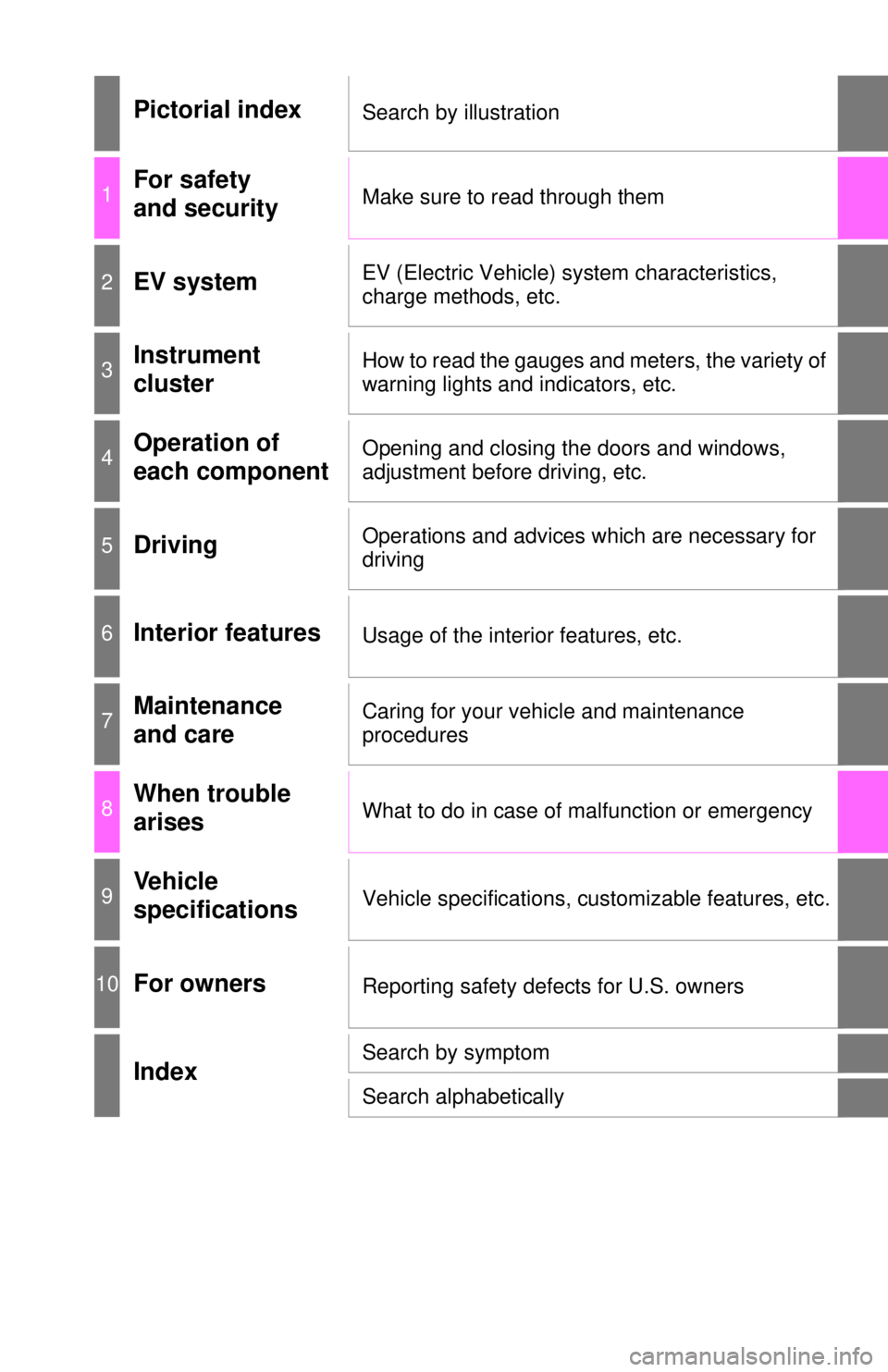
Pictorial indexSearch by illustration
1For safety
and securityMake sure to read through them
2EV systemEV (Electric Vehicle) system characteristics,
charge methods, etc.
3Instrument
clusterHow to read the gauges and meters, the variety of
warning lights and indicators, etc.
4Operation of
each componentOpening and closing the doors and windows,
adjustment before driving, etc.
5DrivingOperations and advices which are necessary for
driving
6Interior featuresUsage of the interior features, etc.
7Maintenance
and careCaring for your vehicle and maintenance
procedures
8When trouble
arisesWhat to do in case of malfunction or emergency
9Vehicle
specificationsVehicle specifications, customizable features, etc.
10For ownersReporting safety defects for U.S. owners
IndexSearch by symptom
Search alphabetically
Page 2 of 444

TABLE OF CONTENTS2
For your information....................... 6
Reading this manual .................... 10
How to search .............................. 11
Pictorial index .............................. 12
1-1. For safe useBefore driving ...................... 22
For safety drive ................... 24
Seat belts ............................ 26
SRS airbags ........................ 32
Front passenger occupant classification system ......... 45
Safety information for children ........................ 51
Child restraint systems ........ 52
Installing child restraints ...... 57
1-2. Theft deterrent system Immobilizer system ............. 66
Theft prevention labels ........ 68
2-1. Electric vehicle Electric vehicle’s day ........... 70
Characteristics of the EV (Electric Vehicle)
system............................... 72
EV (Electric Vehicle) system precautions ........... 79
2-2. Charging Charging equipment ............ 84
Power sources that can be used ............................. 88
Charge methods.................. 91 2-3. Driving the EV
(Electric Vehicle)
EV (Electric Vehicle)
driving tips ........................... 94
3. Instrument cluster Warning lights and indicators .................. 100
Gauges and meters ........... 105
Multi-information display .... 108
4-1. Key information Keys................................... 118
4-2. Opening, closing and locking the doors
Smart key system .............. 120
Wireless remote control ..... 130
Side doors ......................... 132
Back door .......................... 134
4-3. Adjusting the seats Front seats......................... 138
Rear seats ......................... 140
4-4. Adjusting the steering wheel and mirrors
Steering wheel ................... 143
Inside rear view mirror ....... 144
Outside rear view mirrors ............................. 145
4-5. Opening, closing the windows
Power windows.................. 147
1For safety and security
2EV system
3Instrument cluster
4Operation of
each component
Page 3 of 444

3
9 8
7
6
5
4
3
10
1
2
5-1. Before drivingDriving the vehicle ............. 150
Cargo and luggage............ 159
Vehicle load limits ............. 162
Trailer towing..................... 163
Dinghy towing.................... 164
5-2. Driving procedures Power (ignition) switch ...... 165
Transmission ..................... 171
Turn signal lever................ 173
Parking brake .................... 174
Horn .................................. 175
5-3. Operating the lights and wipers
Headlight switch ................ 176
Windshield wipers and washer ..................... 178
Rear window wiper and washer ..................... 180
5-4. How to charge Normal charging ................ 181
Quick charging .................. 195
Timer charging (normal charging only) ................. 202
5-5. Using the driving support systems
Driving assist systems....... 210
Hill-start assist control ....... 213
5-6. Driving tips Winter driving tips.............. 215 6-1. Using the air conditioning
system and defogger
Air conditioning system...... 220
Remote Climate Control System for EV ................. 228
Rear window defogger....... 232
HWD (Heated Windshield Defroster) ...... 233
6-2. Using the interior lights Interior lights list................. 234• Interior light ................... 234
6-3. Using the storage features List of storage features ...... 236• Cup holders ................... 237
• Bottle holders ................ 237
Luggage compartment features ........................... 239
6-4. Other interior features Sun visors and vanity mirrors ............ 241
Outside temperature display ............................. 242
Power outlet....................... 243
Seat heaters ...................... 244
Assist grips ........................ 246
5Driving6Interior features
Page 9 of 444
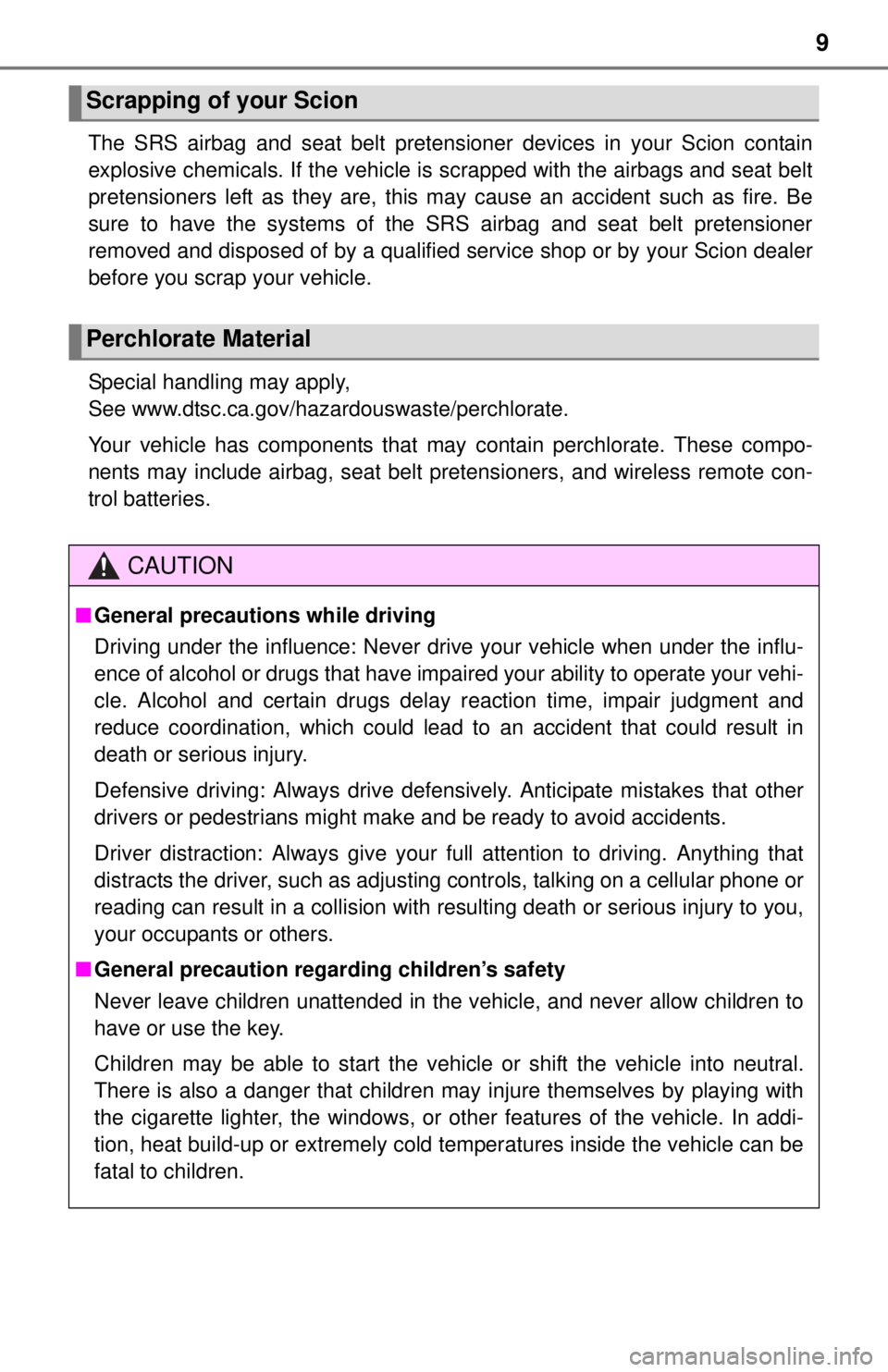
9
The SRS airbag and seat belt pretensioner devices in your Scion contain
explosive chemicals. If the vehicle is scrapped with the airbags and seat belt
pretensioners left as they are, this may cause an accident such as fire. Be
sure to have the systems of the SRS airbag and seat belt pretensioner
removed and disposed of by a qualified service shop or by your Scion dealer
before you scrap your vehicle.
Special handling may apply,
See www.dtsc.ca.gov/hazardouswaste/perchlorate.
Your vehicle has components that may contain perchlorate. These compo-
nents may include airbag, seat belt pretensioners, and wireless remote con-
trol batteries.
Scrapping of your Scion
Perchlorate Material
CAUTION
■General precautions while driving
Driving under the influence: Never drive your vehicle when under the influ-
ence of alcohol or drugs that have impaired your ability to operate your vehi-
cle. Alcohol and certain drugs delay reaction time, impair judgment and
reduce coordination, which could lead to an accident that could result in
death or serious injury.
Defensive driving: Always drive defensively. Anticipate mistakes that other
drivers or pedestrians might make and be ready to avoid accidents.
Driver distraction: Always give your full attention to driving. Anything that
distracts the driver, such as adjusting controls, talking on a cellular phone or
reading can result in a collision with resulting death or serious injury to you,
your occupants or others.
■ General precaution regard ing children’s safety
Never leave children unattended in the vehicle, and never allow children to
have or use the key.
Children may be able to start the vehicle or shift the vehicle into neutral.
There is also a danger that children may injure themselves by playing with
the cigarette lighter, the windows, or other features of the vehicle. In addi-
tion, heat build-up or extremely cold temperatures inside the vehicle can be
fatal to children.
Page 16 of 444
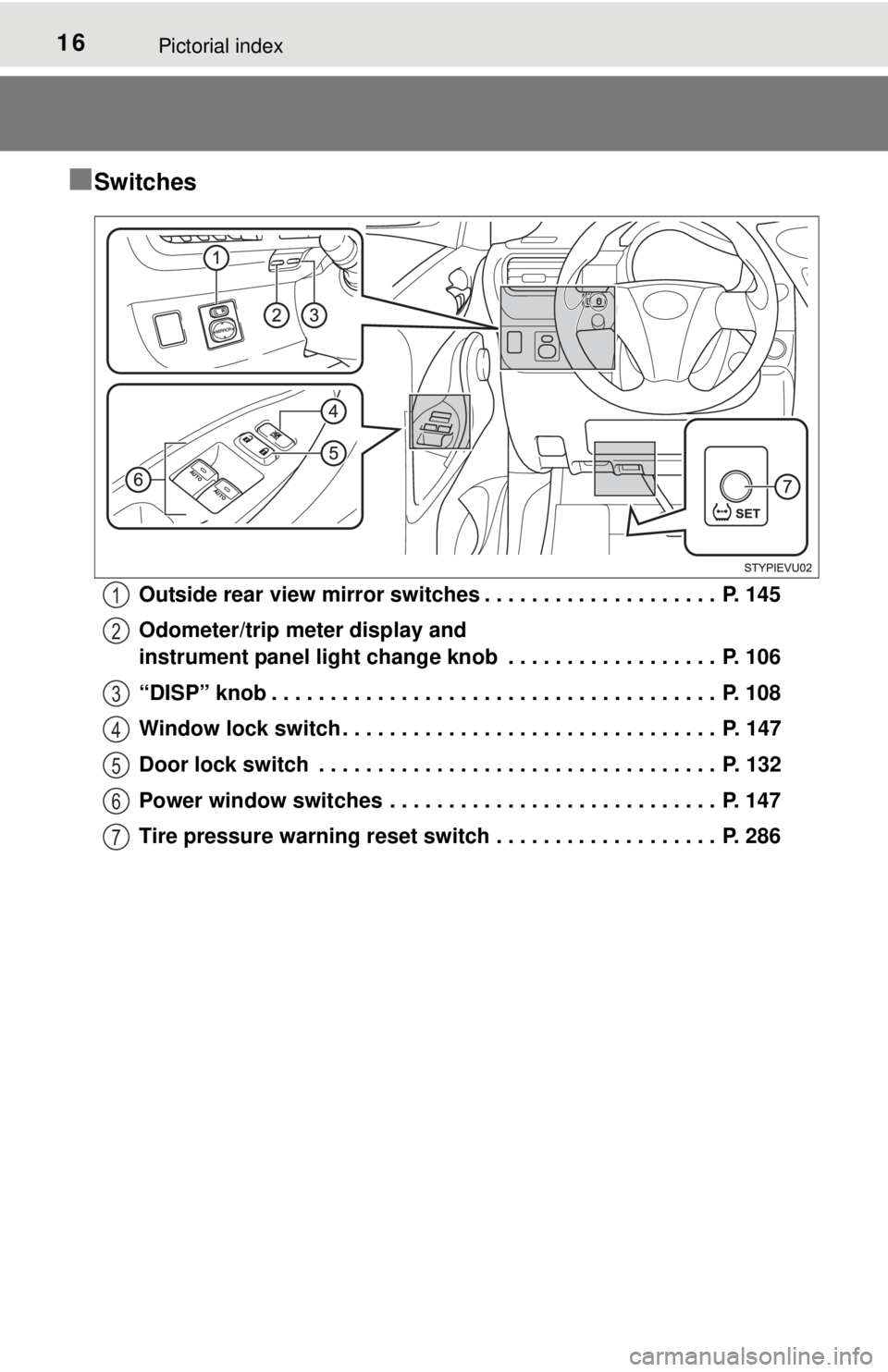
16Pictorial index
■Switches
Outside rear view mirror switches . . . . . . . . . . . . . . . . . . . . P. 145
Odometer/trip meter display and
instrument panel light change knob . . . . . . . . . . . . . . . . . . P. 106
“DISP” knob . . . . . . . . . . . . . . . . . . . . . . . . . . . . . . . . . . . . . . P. 108
Window lock switch . . . . . . . . . . . . . . . . . . . . . . . . . . . . . . . . P. 147
Door lock switch . . . . . . . . . . . . . . . . . . . . . . . . . . . . . . . . . . P. 132
Power window switches . . . . . . . . . . . . . . . . . . . . . . . . . . . . P. 147
Tire pressure warning reset switch . . . . . . . . . . . . . . . . . . . P. 2861
2
3
4
5
6
7
Page 17 of 444
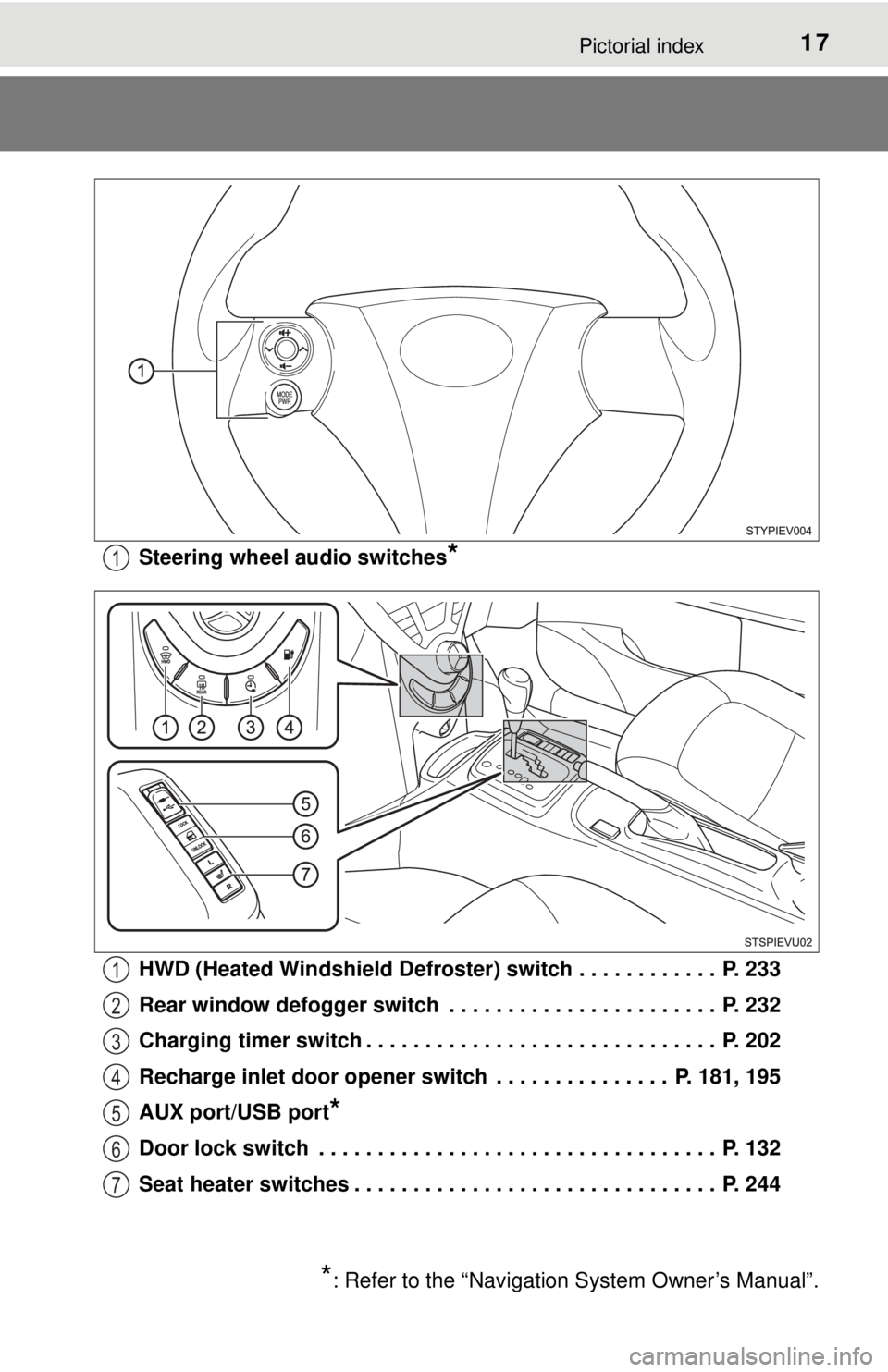
17Pictorial index
Steering wheel audio switches*
HWD (Heated Windshield Defroster) switch . . . . . . . . . . . . P. 233
Rear window defogger switch . . . . . . . . . . . . . . . . . . . . . . . P. 232
Charging timer switch . . . . . . . . . . . . . . . . . . . . . . . . . . . . . . P. 202
Recharge inlet door opener switch . . . . . . . . . . . . . . . P. 181, 195
AUX port/USB port
*
Door lock switch . . . . . . . . . . . . . . . . . . . . . . . . . . . . . . . . . . P. 132
Seat heater switches . . . . . . . . . . . . . . . . . . . . . . . . . . . . . . . P. 244
*: Refer to the “Navigation System Owner’s Manual”.
1
1
2
3
4
5
6
7
Page 33 of 444

331-1. For safe use
1
For safety and security
◆SRS front airbags
SRS driver airbag/front passenger airbag
Can help protect the head and chest of the driver and front passen-
ger from impact with interior components.
SRS knee airbags
Can help provide driver and front passenger protection.
SRS seat cushion airbags
Can help restrain the driver and front passenger.
◆SRS side and curtain shield airbags
SRS side airbags
Can help protect the torso of the front seat occupants.
SRS curtain shield airbags
Can help protect primarily the head of occupants.
◆Other SRS airbag
SRS rear window curtain shield airbag
Can help protect primarily the head of rear occupants.
1
2
3
4
5
6
Page 34 of 444
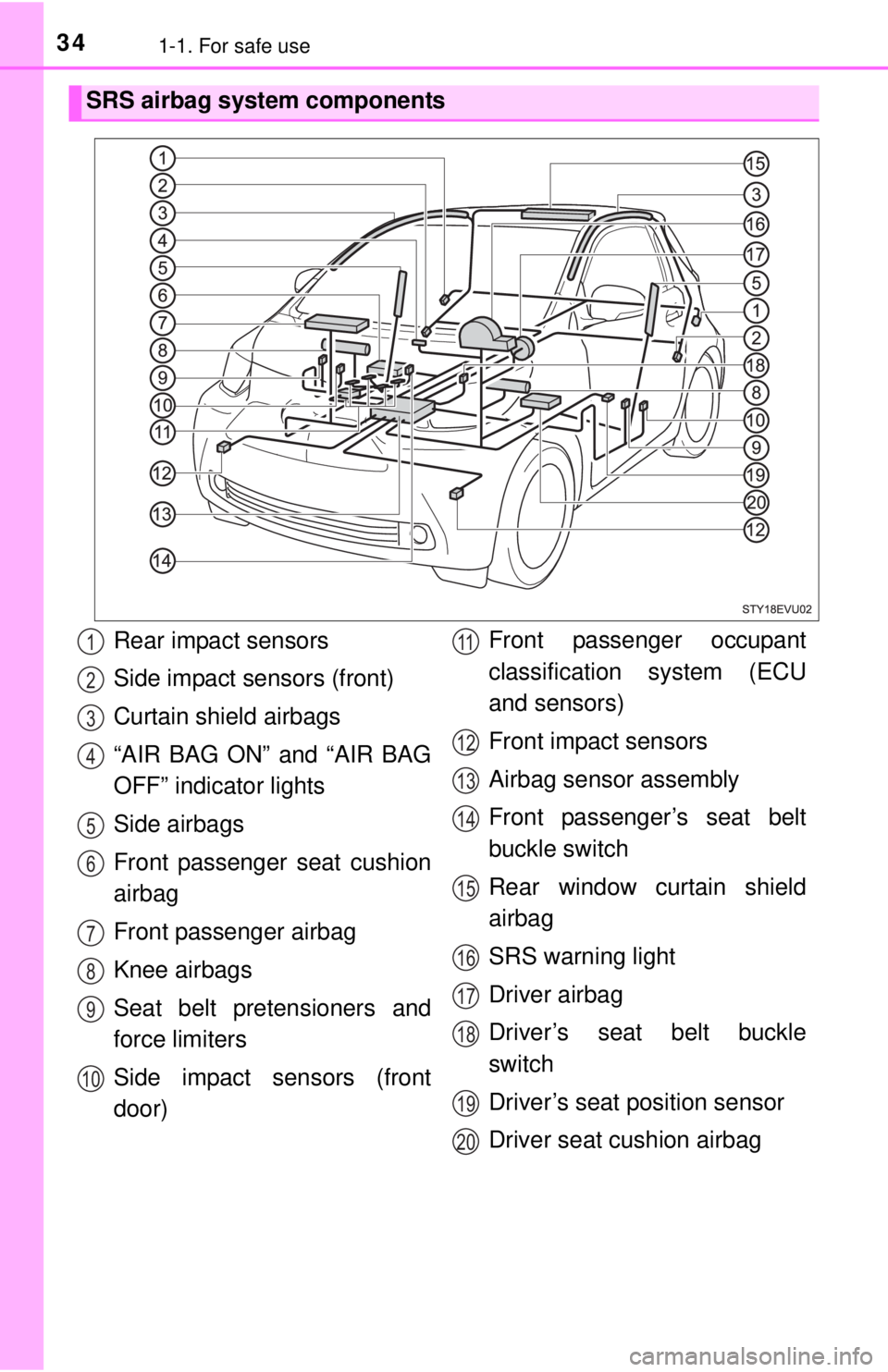
341-1. For safe use
SRS airbag system components
Rear impact sensors
Side impact sensors (front)
Curtain shield airbags
“AIR BAG ON” and “AIR BAG
OFF” indicator lights
Side airbags
Front passenger seat cushion
airbag
Front passenger airbag
Knee airbags
Seat belt pretensioners and
force limiters
Side impact sensors (front
door)Front passenger occupant
classification system (ECU
and sensors)
Front impact sensors
Airbag sensor assembly
Front passenger’s seat belt
buckle switch
Rear window curtain shield
airbag
SRS warning light
Driver airbag
Driver’s seat belt buckle
switch
Driver’s seat position sensor
Driver seat cushion airbag1
2
3
4
5
6
7
8
9
10
11
12
13
14
15
16
17
18
19
20
Page 38 of 444
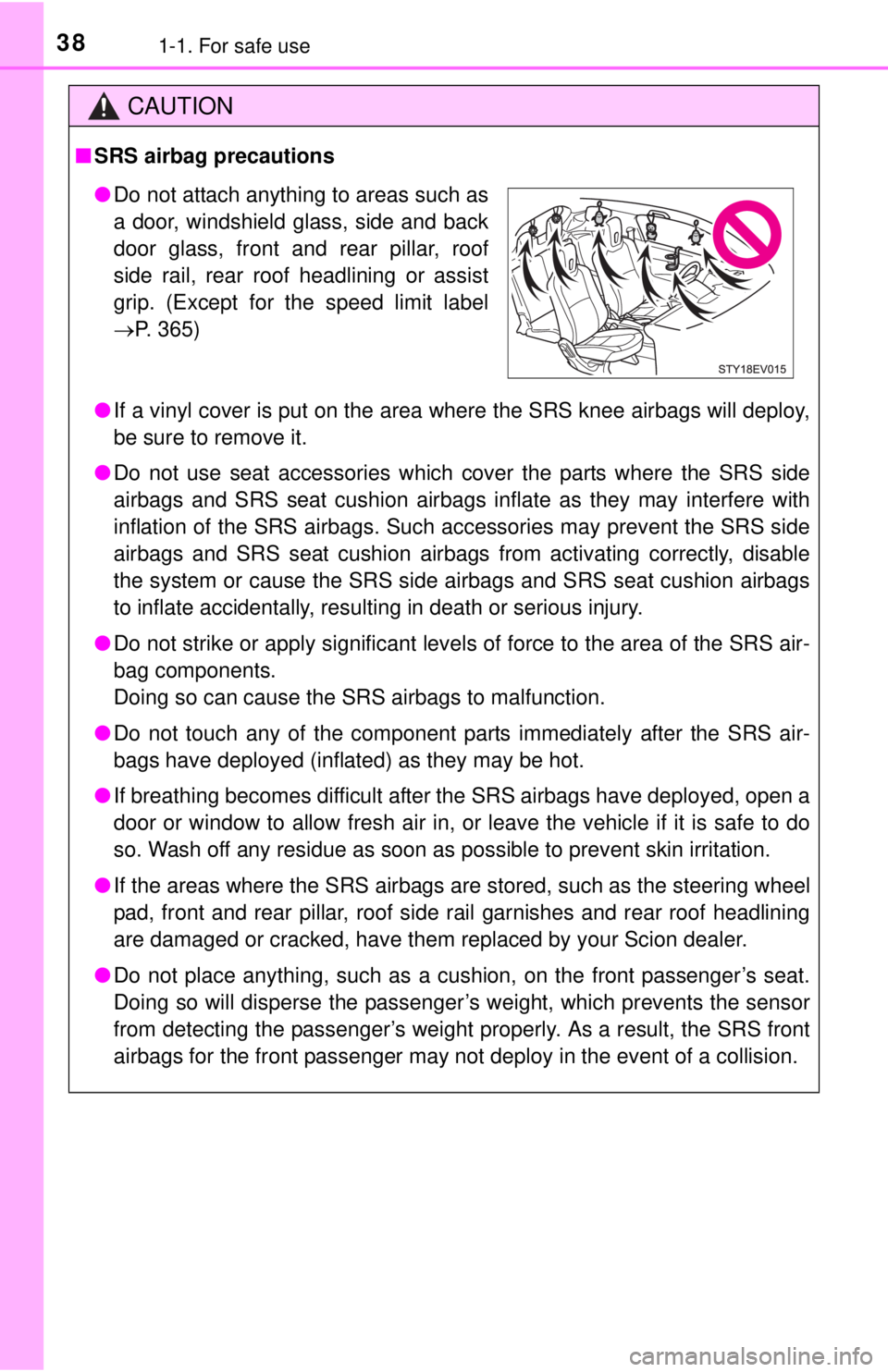
381-1. For safe use
CAUTION
■SRS airbag precautions
● If a vinyl cover is put on the area where the SRS knee airbags will deploy,
be sure to remove it.
● Do not use seat accessories which cover the parts where the SRS side
airbags and SRS seat cushion airbags inflate as they may interfere with
inflation of the SRS airbags. Such accessories may prevent the SRS side
airbags and SRS seat cushion airbags from activating correctly, disable
the system or cause the SRS side airbags and SRS seat cushion airbags
to inflate accidentally, resulting in death or serious injury.
● Do not strike or apply significant levels of force to the area of the SRS air-
bag components.
Doing so can cause the SRS airbags to malfunction.
● Do not touch any of the component parts immediately after the SRS air-
bags have deployed (inflated) as they may be hot.
● If breathing becomes difficult after the SRS airbags have deployed, open a
door or window to allow fresh air in, or leave the vehicle if it is safe to do
so. Wash off any residue as soon as possible to prevent skin irritation.
● If the areas where the SRS airbags are stored, such as the steering wheel
pad, front and rear pillar, roof side rail garnishes and rear roof headlining
are damaged or cracked, have them replaced by your Scion dealer.
● Do not place anything, such as a cushion, on the front passenger’s seat.
Doing so will disperse the passenger’s weight, which prevents the sensor
from detecting the passenger’s weight properly. As a result, the SRS front
airbags for the front passenger may not deploy in the event of a collision.
●Do not attach anything to areas such as
a door, windshield glass, side and back
door glass, front and rear pillar, roof
side rail, rear roof headlining or assist
grip. (Except for the speed limit label
P. 365)
Page 40 of 444

401-1. For safe use
■SRS airbag deployment conditions (SRS front airbags)
●The SRS front airbags will deploy in the event of an impact that exceeds the
set threshold level (the level of force corresponding to an approximately 12 -
18 mph [20 - 30 km/h] frontal collision with a fixed wall that does not move or
deform).
However, this threshold velocity will be considerably higher in the following
situations:
• If the vehicle strikes an object, such as a parked vehicle or sign pole,
which can move or deform on impact
• If the vehicle is involved in an underride collision, such as a collision in which the front of the vehicle “underrides”, or goes under, the bed of a
truck
● Depending on the type of collision, it is possible that only the seat belt pre-
tensioners will activate.
● The SRS front airbags for the front pass enger will not activate if there is no
passenger sitting in the front passenger seat. However, the SRS front air-
bags for the front passenger may deploy if luggage is put in the seat, even if
the seat is unoccupied.
● The SRS seat cushion airbags on the front seats will not operate if the occu-
pant is not wearing a seat belt.
■ SRS airbag deployment conditions (SRS side and curtain shield airbags)
● The SRS side and curtain shield airbags will deploy in the event of an
impact that exceeds the set threshold level (the level of force corresponding
to the impact force produced by an approximately 3300 lb. [1500 kg] vehicle
colliding with the vehicle cabin from a direction perpendicular to the vehicle
orientation at an approximate speed of 12 - 18 mph [20 - 30 km/h]).
● The SRS side and curtain shield airbags may also deploy in the event of a
severe rear collision.
● The SRS curtain shield airbags may also deploy in the event of a severe
frontal collision.
■ SRS airbag deployment conditions (S RS rear window curtain shield air-
bag)
The SRS rear window curtain shield airbag is designed to inflate when the
passenger compartment is subjected to a severe impact from the rear or side.